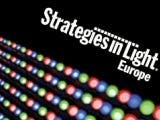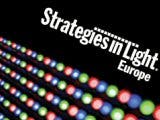The Call for Papers is now CLOSED.
Introduction The global lighting industry is currently going through a remarkable period of transformation, under the influence of energy-efficiency and environmental concerns as well as rapid developments in LED technology.Strategies in Light Europe will address these issues and provide a forum for debate between members of the lighting industry, the lighting design community, the LED manufacturing supply chain, policy makers, standards organizations and other key stakeholders.
Held for the first time in 2010, SIL Europe builds on the success of the flagship Strategies in Light event in California, now in its 11th year, and SIL Japan, which was launched in 2008.
Main Conference
The main conference sessions will be held on Tuesday 28th and Wednesday 29th September. Speakers will focus on issues such as:
- critical challenges and barriers to adoption
- regulatory issues and standards
- government support and funding
- technology updates and roadmaps
- the supply chain
- financing
- the competitive landscape
Workshops
SIL Europe will commence with two half-day workshops on Monday 27th September.
- Workshop A - "Standards for LED lighting: what's the current status and where are the gaps?"
- Workshop B - "Building the Perfect Luminaire: essential considerations when designing effective LED lighting."
The conference will focus on important and timely themes that relate to the ongoing development of the LED lighting industry. Some of these themes are listed below, but other subject areas will be considered.
Presentations with an overly commercial theme, or that focus on promoting a company's products or technology, will not be accepted for the conference.
If your paper is not selected for presentation at the conference, you will be invited to submit a paper for the Conference Proceedings website. This website will be accessible to all conference attendees, and papers will be promoted via the Conference Guide and the LEDs Magazine website.
The following themes are not an exhaustive list, but indicate the scope of the conference:
Markets and Applications
- Market growth and outlook, penetration of LEDs into key applications
- Reasons to adopt LEDs, and barriers to further market penetration
- Case studies of specific installations: cost and performance analysis, user feedback, lessons learned
- Developments in non-lighting markets: display backlighting, projection, automotive, medical etc
- European perspectives on the value and benefits of LED-based lighting
- Lighting designers and specifiers; how are their requirements being met by LED lighting
- Standard and light quality metrics, regulations and legislation
- How are European Directives impacting the LED and lighting markets?
- Quality control and labeling programs
- Customer awareness and acceptance, incentives and subsidies
- Funding from governments and investment community
- Will LEDs and OLEDs dominate the future lighting landscape?
- Opportunities and potential for LED cost reduction
- Supply and demand; capacity constraints and expansion
- Advanced chip design and lower-cost manufacturing; growth on 6-inch wafers
- Consistency; narrower bins and color-point control
- Drivers, dimming and control networks
- Thermal management, and advanced packaging & optical concepts
- Replaceable modules and light-engines
- Test & measurement, photometry
- OLEDs and other competing technologies







